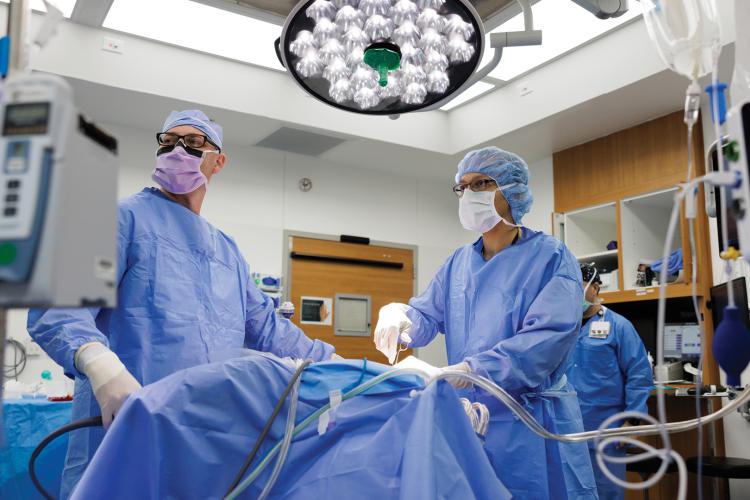
At JPS Health Network, we emphasize the importance of multidisciplinary care, which involves bringing together various medical specialties to provide our patients with comprehensive, life-saving treatment. When multiple specialties come together, physicians can discuss the best options for each patient, ensuring that they receive the necessary care to begin the healing process and reduce recovery times. Scott Throneberry's experience with this type of care enabled him to undergo surgery and recover faster than with the traditional way of conducting this procedure.
Throneberry was diagnosed with cancer around 2021, which is when he began his journey with JPS. Shortly after being diagnosed, he started chemotherapy to help shrink the tumors in preparation for his surgery to remove them. While fighting this battle, he received the news that the cancer had metastasized.
"Throneberry has a history of colorectal cancer, which he previously received surgery and chemotherapy for, but then he was found to have nodules in both lungs and the liver. So, he underwent diagnostic evaluation, and these were suspected to be new sites of cancer that was spread from the previously treated cancer," said Ganesh Kumpati, MD, Cardiothoracic Vascular Surgeon. "The decision from all of the treating physicians was to remove the nodules in the lungs and then the liver."
"This is a relatively new approach to handling these sorts of issues. Even though the main technologies about both bronchoscopy procedures and minimally invasive robotic surgical procedures have existed for some time, this technique of combining them is newer, so we want to show that we are operating with the most current practices."
Although removing the nodules is the most effective way to prevent the cancer from spreading, it is a challenging procedure for physicians, and the impact on the patient is less than ideal.
"With this procedure, let's say the nodules are in the right lower part of the lung because they are so small you have to take the whole lower part of the lung because the surgeon can't really pinpoint it, and so what happens is it makes it difficult for patients to walk and do their normal activities," said Paras Patel, MD, Interventional Pulmonologist.
Throneberry underwent surgery on both of his lungs. The right lung was operated on using the traditional method because the nodules were easier to locate. However, the nodules in the left lung were smaller and not easily visible on the surface, making it difficult to determine their exact location.
"There were two options on how to perform this procedure; one is to do a minimally invasive procedure but take out more of his lung. That means more shortness of breath issues in terms of exercise limitations," Dr. Kumpati said. "The second option would be to do open surgery and to take out the minimum amount of lung, but then the open surgery requires a longer recovery period or a higher chance of breathing problems and complications."
The two procedures have successfully removed nodules from the lungs, but they significantly impact the patient's long-term quality of life. Dr. Kumpati recommends minimally invasive procedures as the preferred approach due to their better outcomes.
"With this kind of disease, we want to take out the nodules with the minimum amount of lung removal and use a minimally invasive approach because it has improvements in terms of lower complications and faster recovery time period," Dr. Kumpati said. "The issue with being minimally invasive with these types of procedures is finding these nodules in the lung because they're relatively small areas to find."
Dr. Kumpati and Dr. Patel teamed up with the goal of performing the procedure with minimal impact. They decided to incorporate Dr. Patel's expertise in Ion robotic bronchoscopy, a minimally invasive technique that allows him to use the Ion machine to help reduce the procedure's negative impacts on patients.
"With this new technique, using the Ion machine allows me to go to the spot and mark it with dye," said Dr. Patel. "We do a CAT scan, so we know where it is. Then, I feed in the Ion machine and find the spot. Once I find the spot, I inject dye into it, and Dr. Kumpati takes over. It's a single anesthesia procedure, and two days later, the patient is discharged and can go back to work. Normally, when the patient had to get the whole lower part of the lung removed, recovery time might be about a week to two weeks.”
JPS aims to offer patients the best care and continuously seeks ways to maintain and improve their quality of life. Throneberry explains that this method of performing the procedure has shown a noticeable difference from the first procedure he received on his right lung.
"This second procedure, I noticed a big difference between the two," Throneberry said. "It didn't take as long, getting up and down, and getting discharged from the hospital. It really differed from the first one. With the second procedure, I went in on Thursday and was discharged on Saturday, but with the first one, I was in the hospital for a little bit longer."
JPS is always looking for ways to improve and enhance patient care. Combining these two specialties allowed us to fulfill our mission and provide Throneberry with exceptional care.
"This is a relatively new approach to handling these sorts of issues. Even though the main technologies about both bronchoscopy procedures and minimally invasive robotic surgical procedures have existed for some time, this technique of combining them is newer, so we want to show that we are operating with the most current practices," Kumpati said.
